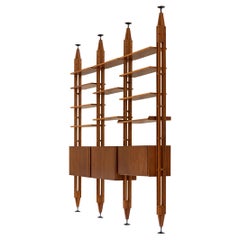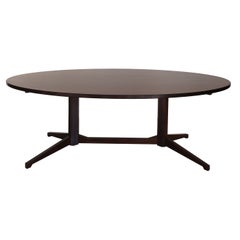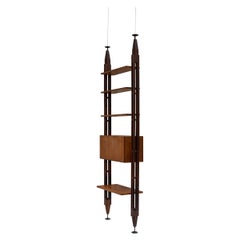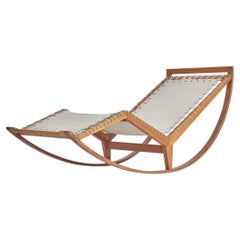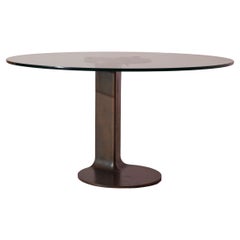Poggi Furniture
to
7
68
3
71
1
50
3
1
70
1
54
16
1
33
16
15
1
65
15
14
13
12
70
70
72
72
72
48
8,866
3,914
2,538
2,229
Creator: Poggi
Lb7 bookcase, designed by Franco Albini for Poggi Pavia, Italy
By Poggi, Franco Albini
Located in Piacenza, Italy
Modular bookshelf designed by Franco Albini in 1956 for Poggi Pavia.
An exceptionally flexible bookshelf with various modular options, suitable to be placed against a wall or used as...
Category
1950s Italian Mid-Century Modern Vintage Poggi Furniture
Materials
Wood
Franco Albini and Franca Helg for Poggi Italian Walnut Dining Table TL22
By Franco Albini and Franca Helg, Poggi
Located in Reggio Emilia, IT
Italian Mid-Century Modern design dining table designed by Franco Albini and Franca Helg and produced by Poggi Pavia from 1958 with veneered walnut top with elliptical shaped longer ...
Category
1950s Italian Mid-Century Modern Vintage Poggi Furniture
Materials
Wood, Walnut
$7,208 Sale Price
20% Off
Midcentury LB7 modular bookcase designed by Franco Albini for Poggi, Italy 1957
By Franco Albini, Poggi
Located in Piacenza, Italy
Modular bookcase model LB7 designed by Franco Albini for Poggi.
Marked Poggi Pavia.
An extremely flexible bookcase, with different modular options, suited to being against a wall or...
Category
1950s Italian Mid-Century Modern Vintage Poggi Furniture
Materials
Wood
Augusto Savini for Pozzi Set of Four 'Pamplona' Dining Chairs in Red Lacquer
By Augusto Savini, Poggi
Located in Waalwijk, NL
Augusto Savini for Pozzi, set of four 'Pamplona' dining chairs, lacquered wood, fabric, aluminum, Italy, 1960s
'Pamplona' armchairs in red lacquered wood and red textured upholster...
Category
1960s Italian Mid-Century Modern Vintage Poggi Furniture
Materials
Aluminum
Franco Albini, Early Rocking "PS16" Chaise Lounge, Sycamore, 1960s, Poggi, Italy
By Franco Albini, Poggi
Located in High Point, NC
A rare and early "PS16", cotton, cord and sycamore rocking chaise lounge designed by Franco Albini and produced by Poggi, Italy, 1950s-1960s.
Category
1960s Italian Mid-Century Modern Vintage Poggi Furniture
Materials
Cotton, Cord, Sycamore
Afra & Tobia Scarpa metal and glass round table model Tl59 by Poggi, Italy 1970s
By Poggi, Afra & Tobia Scarpa
Located in Chiavari, Liguria
A metal and glass table, model TL59, produced by Poggi, designed by Afra & Tobia Scarpa, 1970s
This table features a metal cast base supporting a glass top. Designed by Afra and Tob...
Category
1970s Italian Organic Modern Vintage Poggi Furniture
Materials
Metal
Midcentury Italian Bar Cart Model "Cr20" by Franco Albini for Poggi, 1958
By Poggi, Franco Albini and Franca Helg
Located in Piacenza, Italy
Elegant bar cart Model "Cr20" designed by Franco Albini and Franca Helg for Poggi in Italy, 1958.
Published.
Category
1950s Italian Mid-Century Modern Vintage Poggi Furniture
Materials
Wood
Franco Albini Italian Midcentury Walnut Bar Trolley for Poggi, 1950s
By Franco Albini and Franca Helg, Poggi
Located in Reggio Emilia, IT
Italian midcentury modern design walnut serving trolley bar trolley CR20 designed by Franco Albini & Franca Helg and produced by Poggi Pavia in 1958.
Please note that the item is or...
Category
1950s Italian Mid-Century Modern Vintage Poggi Furniture
Materials
Walnut
Franco Albini Italian Midcentury Dark Wood Sideboard for Poggi, 1950s
By Poggi, Franco Albini
Located in Reggio Emilia, IT
Italian Mid-Century Modern design credenza sideboard designed by Franco Albini and produced by Poggi Pavia from 1958, four doors with sliding shelves and a pull-out shelf / tray, sol...
Category
1850s Italian Mid-Century Modern Antique Poggi Furniture
Materials
Wood
$11,437 Sale Price
20% Off
Franco Albini Sofa mod. DV33 for Poggi
By Franco Albini, Poggi
Located in Turin, Turin
Franco Albini (1905-1977) lived in Milan where he stuied Architecture at the Politecnico. He started his career at Gio Ponti's studio, with whom he collaborated before getting in tou...
Category
1960s Italian Mid-Century Modern Vintage Poggi Furniture
Materials
Fabric, Wood
Golem glossy lacquered chair by Vico Magistretti for Poggi, 1960s
By Vico Magistretti, Poggi
Located in Padova, IT
The Golem chair, designed by Vico Magistretti for Poggi in 1973, is one of the most significant examples of Italian design from the 1970s. Magistretti, known for his ability to combi...
Category
1960s Italian Mid-Century Modern Vintage Poggi Furniture
Materials
Leather, Wood
Franco Albini TL22 wooden desk by Poggi Pavia, Italy, 1950s
By Poggi, Franco Albini
Located in Chiavari, Liguria
Desk with shaped top from the "TL 22" series, wooden structure, italian manufacture from the 1950s, crafted by Poggi and designed by Franco Albini.
This office desk stands out with ...
Category
1950s Italian Mid-Century Modern Vintage Poggi Furniture
Materials
Wood
Set of Two SD51 "Golem" Chairs by Vico Magistretti for Poggi, Italy, 1960s
By Vico Magistretti, Poggi
Located in Milan, IT
Pair of SD51 Golem chair by Vico Magistretti for Poggi.
Sinuous long backrest, lacquered frame and leather covering.
A third single piece available
Category
1960s Italian Vintage Poggi Furniture
Materials
Leather, Wood
Vico Magistretti, Pair of sideboards mod. MB55, prod. Poggi, 1960s
By Vico Magistretti, Poggi
Located in Rivoli, IT
Pair of sideboards mod. MB55
Wood veneer frame with leather top.
Prod. Poggi, 1960s
Small defects and marks due to use.
Category
1960s Italian Vintage Poggi Furniture
Materials
Leather, Wood
Pair of High Back Golem Chairs by Vico Magistretti for Poggi, Italy 1969
By Vico Magistretti, Poggi, Mario Bellini, Afra & Tobia Scarpa
Located in Grand Cayman, KY
Pair of stunning high-back SD51 Golem chairs by Vico Magistretti for Poggi, 1969 Italy. This Post Modern chair plays on the Mid-Century Modern aesthetic of Carlo, Afra and Tobia Scar...
Category
1970s Italian Post-Modern Vintage Poggi Furniture
Materials
Leather, Wood, Bentwood, Paint
Franco Albini Rosewood Mid-Century Modern “LB7” Modular Bookcase for Poggi, 1957
By Poggi, Franco Albini
Located in Vicenza, IT
LB7 bookcase, designed by Franco Albini and manufactured by Poggi in 1957.
Modular bookstore composed by upholds, containers with flying and doors, shelve. The industrial standard for every product component allows permanent and different solutions, from the bearing structures to the elements. The structure does not need anchorages to the wall and can be placed in the middle of the space.
This set is composed of 3 modules, ten shelves, and three containers.
It is made of Rosewood, iron, and brass.
Excellent vintage condition.
Franco Albini was born in Robbiate in 1905, and after his childhood and part of his youth, he moved to Milan.
He graduated at Politecnico of Milan, Faculty of Architecture, in 1929, and He collaborated for three years in Giò Ponti and Emilio Lancia’s office. He probably had his international contacts here, at The International Exposition of 1929 in Barcelona and Paris, where he visited le Corbusier’s office, as Franca Helg used to tell.
Throughout these first three years, his works were undoubtedly related to XIXth Century. His meeting with Edoardo Persico marks an evident turnover towards rationalism and writers for “Casabella” magazine. Persico’s thoughtful and ironical comments on some of Albini’s drawings for office furniture caused him deep upsetting. “I spent days of real anxiety – tells Albini – I had to answer all questions. I had a long fever”.
The new phase that the meeting provoked begins with opening his own first office at Via Panizza with Renato Camus and Giancarlo Palanti. The group of Architects starts taking care of social housing, participating in the competition for the Baracca neighborhood in 1932, and then realizing the Ifacp neighborhood: Fabio Filzi (1936/38), Gabriele D’Annunzio, and Ettore Ponti (1939).
During those years, He also worked for his first private villa (Pestarini).
It is mainly in the context of exhibitions that the Italian architect experiments the compromise between rigor and poetic fantasy that Pagano was talking about; He conceived all the elements that would become recurrent in all types of his work – Architecture, Interiors, Design. The 1933 opening of the new Triennale of Milano, in Palazzo dell’Arte, becomes an occasion to express the highly innovative character of rationalist thinking. In this place, to experiment with new materials and solutions, but most of all a “method”.
Young rationalist architects cultivated the art of exhibiting as a communication lab, an open field to space solutions.
Albini, with Giancarlo Palanti, sets the steel structure house (with R. Camus, G. Mazzoleni, G. Minoletti and coordination by G. Pagano) designing also its furniture. For the next Triennale in 1936, marked by Persico’s early death, Franco Albini, together with a group of young architects around Pagano, takes care of the exhibition of Dwelling, where he presented 3 types of lodgings.
In the same year, Albini and Romano design the exhibition for Ancient Italian jewelry: vertical uprights, simple linear poles design space. This element is recurring in other works, like the Scipione exhibition (1941), Vanzetti stand (1942), and Olivetti shop in Paris (1956). The architectural space is readable through a grid, introducing a third dimension, the vertical one, with a sense of lightness and transparency.
Upright is also used in design objects, such as the Veliero bookcase...
Category
1950s Italian Mid-Century Modern Vintage Poggi Furniture
Materials
Brass, Iron
Set of 2 Franco Albini, "Luisa" chairs, Production Poggi, Pavia
By Franco Albini, Poggi
Located in Wolfurt, AT
This set of two Italian chairs was designed by Franco Albini for Poggi in the 1950s. The "Luisa" model is a simple, timeless design and is made of walnut wood and red fabric on the b...
Category
1950s Italian Mid-Century Modern Vintage Poggi Furniture
Materials
Fabric, Wood
Mid-Century M. 501 Sideboard by Gianfranco Frattini for Bernini, Italy, 1960s
By Gianfranco Frattini, Poggi
Located in Argelato, BO
Rare and beautiful exotic wood sideboard by Gianfranco Frattini for Bernini, Italy, 1960s.
A true classic of Italian Mid-Century design, capable of speaking with style and sophistica...
Category
1960s Mid-Century Modern Vintage Poggi Furniture
Materials
Wood
Franco Albini for Poggi Italian Cicognino Wood Side Table 1950s
By Poggi, Franco Albini
Located in Reggio Emilia, IT
Italian midcentury wood side table model TN6 Cicognino designed by Franco Albini and produced by Poggi Pavia in 1953, production Italy 1960s
Bibliography:
Domus 312 (November 1955),...
Category
1950s Italian Mid-Century Modern Vintage Poggi Furniture
Materials
Wood
$3,748 Sale Price
20% Off
Trolley 'CR20' for Poggi by Franco Albini & Franca Helg, Italy 1958
By Franca Helg, Franco Albini, Poggi
Located in Hellouw, NL
Franco Albini remains a pivotal figure in 20th-century Italian design. Together with Franca Helg, he created a body of work that blends clarity with precision. Their long-standing co...
Category
1950s Italian Mid-Century Modern Vintage Poggi Furniture
Materials
Wood
Set of Four SD51 "Golem" Chairs by Vico Magistretti for Poggi, Italy, 1960s
By Vico Magistretti, Poggi
Located in Lucija, SI
Mid-Century Modern black Lacquered wooden dining chairs Golem by Vico Magistretti, Italy 1969.
Nice set of 4 dining chairs „Golem SD51“ designed by Vico Magistretti for Poggi in 1969...
Category
1960s Italian Mid-Century Modern Vintage Poggi Furniture
Materials
Leather, Wood
6 High Back Golem Chairs by Vico Magistretti for Poggi, Italy 1969
By Mario Bellini, Poggi, Vico Magistretti, Afra & Tobia Scarpa
Located in Grand Cayman, KY
Set of 6 stunning high-back SD51 Golem chairs by Vico Magistretti for Poggi, 1969 Italy. This Post Modern chair plays on the Mid-Century Modern aesthetic of Carlo, Afra and Tobia Sca...
Category
1970s Italian Post-Modern Vintage Poggi Furniture
Materials
Leather, Wood, Bentwood, Paint
Rare Mahogany 'TL2' Cavalletto Table / Desk by Franco Albini for Poggi, Italy
By Poggi, Franco Albini
Located in London, GB
A rare mahogany version of the Cavaletto or TL2 table designed by the great neo-rationalist designer, Franco Albini. Designed in 1950 for manufacturers Poggi...
Category
1950s Italian Mid-Century Modern Vintage Poggi Furniture
Materials
Steel
Franco Albini "Cicognino" teak side table by Poggi, model TN6, Italy, 1950s
By Poggi, Franco Albini
Located in Chiavari, Liguria
A wooden serving table, model TN6 "Cicognino", manufactured in Italy by Poggi, design by Franco Albini, 1950s.
Some objects embody the quintessence of great design. They possess per...
Category
1950s Italian Mid-Century Modern Vintage Poggi Furniture
Materials
Teak
Franco Albini and Franca Helg pair of stools for the Marlborough Gallery, 1962
By Poggi, Franco Albini and Franca Helg
Located in Milan, IT
A rare pair of stools by Architects Franco Albini and Franca Helg.
Made for the Marlborough Gallery in Rome, Italy, 1962.
Expertise by Fondazione Franco Albini is available.
Two pai...
Category
1960s Italian Mid-Century Modern Vintage Poggi Furniture
Materials
Leather, Wood
Chest of drawers by Franco Albini for poggi, Italy, 1958
By Franco Albini, Poggi
Located in ALHAURÍN EL GRANDE, ES
Chest of drawers
A variant of model “CM24”
Manufactured by Poggi
Italy, 1958
Walnut, black metallic wheels and patinated brass details.
Measurements
58 L cm x 43 W cm x 59 H cm
Pro...
Category
1950s Italian Mid-Century Modern Vintage Poggi Furniture
Materials
Brass
$1,892 Sale Price
25% Off
Franco Albini for Poggi Italian Midcdentury Dark Wood Sideboard, 1960s
By Franco Albini, Poggi
Located in Reggio Emilia, IT
Italian midcentury modern design little credenza sideboard "MB48" model designed by Franco Albini and produced by Poggi with stained walnut wood and brass details, made in Italy 1960...
Category
1960s Italian Mid-Century Modern Vintage Poggi Furniture
Materials
Wood
Franco Albini for Poggi 'MB15' Large Sideboard in Teak
By Franco Albini, Poggi
Located in Waalwijk, NL
Franco Albini for Poggi, sideboard, model 'MB15', teak, Italy, 1957
This well-designed, sizable sideboard by Franco Albini for Poggi, created in 1950s Italy, epitomizes mid-century ...
Category
1950s Italian Mid-Century Modern Vintage Poggi Furniture
Materials
Teak
Franco Albini for Poggi Cabinet in Teak
By Franco Albini, Poggi
Located in Waalwijk, NL
Franco Albini for Poggi, cabinet, model ‘MB51’, teak, Italy, 1958
This exquisitely designed cabinet by Franco Albini for Poggi epitomizes simplicity with its sharp, clean lines. Th...
Category
1950s Italian Mid-Century Modern Vintage Poggi Furniture
Materials
Teak
Franco Albini “PS16” Rocking Chair for Poggi, 1959
By Franco Albini, Poggi
Located in Lonigo, Veneto
Franco Albini “PS16” rocking chair for Poggi, original fabric and walnut, Italy, 1959.
The Albini "PS16" is a rocking chair with a timeless design. Manuf...
Category
1950s Italian Mid-Century Modern Vintage Poggi Furniture
Materials
Walnut, Fabric
20th Century Franco Albini for Poggi Wooden Cabinet mod. MB15
By Poggi, Franco Albini
Located in Turin, Turin
Franco Albini (1905-1977) lived in Milan where he stuied Architecture at the Politecnico. He started his career at Gio Ponti's studio, with whom he collaborated before getting in tou...
Category
1950s Italian Mid-Century Modern Vintage Poggi Furniture
Materials
Wood
Franco Albini LB7 Bookcase in Teak Wood by Poggi Pavia 1950s Italy
By Poggi, Franco Albini
Located in Montecatini Terme, IT
LB7 bookcase composed of a single module with shelves and a storage unit with two doors, made in veneered solid teak wood, and black lacquered metal details.
Designed by Franco Alb...
Category
1950s Italian Mid-Century Modern Vintage Poggi Furniture
Materials
Metal
20th Century Franco Albini Pair of TN6 Cicognino Coffee Tables in Wood, 50s
By Poggi, Franco Albini
Located in Turin, Turin
An iconic design with a refined and essential taste, which in its playful form evokes a reassuring feeling of familiarity. Franco Albini created the table by reducing its structure t...
Category
1950s Italian Mid-Century Modern Vintage Poggi Furniture
Materials
Wood
20th Century, Franco Albini Sofa mod. DV33 for Poggi
By Poggi, Franco Albini
Located in Turin, Turin
Franco Albini (1905-1977) lived in Milan where he stuied Architecture at the Politecnico. He started his career at Gio Ponti's studio, with whom he collaborated before getting in tou...
Category
1960s Italian Mid-Century Modern Vintage Poggi Furniture
Materials
Fabric, Wood
$13,215 / item
Franco Albini Cicognino Side Table in Wood by Poggi Pavia, 1970s Italy
By Franco Albini, Poggi
Located in Bagnolo Mella, Brescia
This exquisite Cicognino side table, designed by Franco Albini and produced by Poggi Pavia in the 1970s, is a timeless piece of Italian design. Crafted from high-quality wood, this t...
Category
1970s Italian Mid-Century Modern Vintage Poggi Furniture
Materials
Wood, Teak
Rare of Sideboard "Mb15" by Franco Albini for Poggi
By Poggi, Franco Albini and Franca Helg
Located in Rovereta, Repubblica di San Marino
Rare of walnut sideboard model "Mb15" by Franco Albini for Poggi.
Perfect condition.
Category
Mid-20th Century Italian Mid-Century Modern Poggi Furniture
Materials
Walnut
Franco Albini PL19 or Tre Pezzi Armchair in White Wool by Poggi Pavia, 1950s
By Franco Albini and Franca Helg, Poggi
Located in Montecatini Terme, IT
PL19 also known as Tre Pezzi armchair with black enameled steel tube structure, upholstered in white Mongolian goat wool.
Designed by Franco Albini & Franca Helg for Poggi, Pavia...
Category
1950s Italian Post-Modern Vintage Poggi Furniture
Materials
Steel
LB65 Vitrine by Marco Zanuso for Poggi, Italy, 1970s
By Poggi, Marco Zanuso
Located in Milan, IT
Rare vitrine - storage unit model Lb65 by Marco Zanuso for Poggi.
Glass shelves three doors featuring Carabottino wood frame.
An apparently simple piece, mastery assembled by Poggi.
Category
1970s Italian Vintage Poggi Furniture
Materials
Glass, Wood
Cavalletto Dining or Working Table by Franco Albini for Poggi
By Poggi, Franco Albini
Located in Barcelona, ES
Cavalletto or TL2 dining or working table designed in 1950 by italian architect Franco Albini, old Poggi edition. Wood construction with beveled edges tabletop and crossed legs with ...
Category
1950s Italian Mid-Century Modern Vintage Poggi Furniture
Materials
Metal
Franco Albini LIBRERIA LB7, ANNI '50
By Poggi, Franco Albini
Located in Baranzate, IT
Libreria LB7 in legno di teak e composta da due moduli e otto ripiani. Disegnata da Franco Albini per Poggi negli anni '50.
Category
1950s Italian Mid-Century Modern Vintage Poggi Furniture
Materials
Wood
Luisella dining chairs by Franco Albini, ed.Poggi 1955
By Poggi, Franco Albini
Located in Renens, CH
Rare suite of six “Luisella” chairs by Franco Albini for Carlo Poggi, Pavia, Italy 1955. Teak and cotton fabric.
After working for some 15 years on several prototypes of the model, Italian designer, architect and urban planner Franco Albini (1905-77) completed what is considered a masterpiece: the Luisa armchair, with armrests, and Luisella, the chair without armrests. The final teak version was put into production by Carlo Poggi in 1955.
The Luisa is often compared to the equally minimal and robust Leggera chair, designed by architect and designer Giò Ponti, with whom Albini apprenticed after graduating in architecture from Milan's Polytechnic University in 1929.
Albini's blend of functionalism and style earned him numerous awards, including the 1955 Compasso d'Oro, a prestigious Italian prize for excellence in industrial design. (Award created by Gio Ponti in 1954).
It is also in the permanent collection of the Museum of Modern Art in New York.
The Luisa chair, with armrests, is still produced by Cassina. The Luisella chair, without armrests, is no longer produced.
The chairs has been bought by the first owner together with a Chelsea Table by Vittorio Introini for Saporiti that we have also in stock at the Galleria...
Category
1950s Italian Mid-Century Modern Vintage Poggi Furniture
Materials
Fabric, Wood
Vico Magistretti, Coppia di cassettiere mod. Sammarcanda, prod. Poggi, 1969
By Poggi, Vico Magistretti
Located in Rivoli, IT
Coppia di rare cassettiere mod. Sammarcanda prodotte da Poggi su disegno dell'architetto Vico Magostretti dal 1969.
Samarcanda è un sistema di cassetti indipendenti che si possono l...
Category
1960s Italian Vintage Poggi Furniture
Materials
Leather, Wood
White Wood and Black Skai Samarcanda Chest of Drawers by Magistretti for Poggi
By Vico Magistretti, Poggi
Located in Varese, Lombardia
Wooden structure painted in white polyurethane color. Black skai cover on the top (light defects at some corner).
Large chest of drawers: cm 34,5h x 107w x 53,5d
Small chest of dra...
Category
1970s Italian Space Age Vintage Poggi Furniture
Materials
Faux Leather, Wood
Franco Albini for Poggi Table or Desk, Italy, 1960s
By Franco Albini, Poggi
Located in Almelo, NL
Franco Albini Table or Desk for Poggi, Italy, 1960s
This walnut table or desk, model T22, was designed by Franco Albini for Poggi in Italy during the 1960s. It is in excellent condi...
Category
Mid-20th Century Italian Mid-Century Modern Poggi Furniture
Materials
Wood, Walnut
Franco Albini Stunning wood MB15 Sideboard for Poggi, Italian Design 1950s
By Franco Albini, Poggi
Located in Milan, IT
Modern sideboard by Franco Albini for Poggi - 1950s Italy.
This design features a simplistic aesthetic with sharp lines. It has four compartments with doors. The sculptural legs giv...
Category
1950s Italian Vintage Poggi Furniture
Materials
Wood, Walnut
Italian Franco Albini for Poggi Sideboard
By Poggi, Franco Albini
Located in Hudson, NY
An Italian model MB 51 sideboard designed by Franco Albini for Poggi. Made of solid teak with a minimalist design and sharp lines.
Category
Mid-20th Century Italian Mid-Century Modern Poggi Furniture
Materials
Teak
Franco Albini Pl19 or Tre Pezzi Armchair in Black Mongolian Wool for Poggi Italy
By Poggi, Franco Albini and Franca Helg
Located in Montecatini Terme, IT
PL19 also known as Tre Pezzi armchair with black enameled steel tube structure, upholstered in black Mongolian goat wool.
Designed by Franco Albini & Franca Helg for Poggi, Pavia...
Category
1950s Italian Other Vintage Poggi Furniture
Materials
Steel
$17,300 Sale Price
31% Off
Franco Albini & Franca Helg for Poggi, Mid-century Rocking Chair Mod. PS16, 1956
By Franco Albini and Franca Helg, Poggi
Located in Milan, IT
Franco Albini & Franca Helg for Poggi, Italian Mid-century Wooden Rocking Lounge Chair Model PS16
Manufactured by Poggi, Pavia, Italy. Together with a certificate of authenticity ...
Category
1950s Italian Mid-Century Modern Vintage Poggi Furniture
Materials
Fabric, Wood
Vintage Dresser Model CS49 by Vico Magistretti for Poggi Productions Italy 1970s
By Vico Magistretti, Poggi
Located in Roma, IT
Vintage dresser model CS49 by Vico Magistretti for Poggi Productions, Italy 1970s dresser model CS49 is an original design dresser created by Vico Magistretti (Milan, 1920-Milan, 200...
Category
1970s Italian Vintage Poggi Furniture
Materials
Wood
$1,441 Sale Price
25% Off
Sedie modello ''Golem'' di Vico Magistretti per Poggi, 1960s, set di 6
By Vico Magistretti, Poggi
Located in Quarrata, IT
Sedie di Vico Magistretti prodotte da Poggi, in Italia, negli anni '60.
Struttura in legno laccato marrone originale e sedute nuovamente ritappezzate in pelle di camoscio.
Category
1960s Vintage Poggi Furniture
Materials
Leather, Suede, Wood
Franco Albini, Luisella Chair for Poggi, Italy 1950s, model SD9
By Poggi, Franco Albini and Franca Helg
Located in Wargrave, Berkshire
Designed by Franco Albini and Franca Helg and manufactured in Italy by Poggi in the late 1950s, the Luisa and Luisella chairs have become icons of Italian mid-century design.
The fr...
Category
1950s Italian Mid-Century Modern Vintage Poggi Furniture
Materials
Fabric, Walnut
Mb 48 Wood Case Piece by Franco Albini for Poggi, Italy, 1960s
By Franco Albini, Poggi
Located in Milan, IT
Mb 48 Case piece by Franco Albini for Poggi.
Capable modular piece to be used standing alone or connected to more elements of the same project.
Category
1960s Italian Vintage Poggi Furniture
Materials
Wood
Marco Zanuso, Six dining chairs mod. SD57, prod. 70s Poggi
By Marco Zanuso, Poggi
Located in Rivoli, IT
Set of six dining chairs mod. SD57, prod. Poggi 1970s.
Wooden frame, leather seat
Some defects on the seats
Category
1970s Italian Vintage Poggi Furniture
Materials
Leather, Wood
FRANCO ALBINI per POGGI Sedia pieghevole
By Franco Albini, Poggi
Located in Baranzate, IT
Sedia pieghevole con struttura in legno massello. Seduta e schienale in legno compensato.
Prod. Poggi, Italia, 1952
Bibliografia Catalogo esibizione, Franco Albini & Franca Helg Desi...
Category
1950s Italian Mid-Century Modern Vintage Poggi Furniture
Materials
Wood
Franco Albini MB15 Large Sideboard with Four-Doors Panels in Wood by Poggi 1950s
By Poggi, Franco Albini
Located in Montecatini Terme, IT
MB15 large sideboard with four-door panels in wood, designed by Franco Albini in 1956 and produced by Poggi, Pavia.
The MB15 sideboard showcases a clean and solid design characteriz...
Category
1950s Italian Mid-Century Modern Vintage Poggi Furniture
Materials
Wood
TL 22 Cavalletto table designed by Franco Albini for Poggi Pavia, Italy 1955
By Franco Albini, Poggi
Located in Piacenza, Italy
The TL 22 Cavalletto table, designed by Franco Albini for Poggi Pavia in 1955, is a stunning example of midcentury Italian design. Featuring a minimalist, elegant structure, the tabl...
Category
1950s Italian Mid-Century Modern Vintage Poggi Furniture
Materials
Wood
Capable MB84 Wood Chest of Drawers by Roberto Poggi for Poggi, Italy, 1990s
By Poggi
Located in Milan, IT
MB84 chest of drawers by Roberto Poggi for Poggi.
Capable walnut piece with four drawers and brass details.
Category
1990s Italian Poggi Furniture
Materials
Brass
Franco Albini Set of Two "Model PL19", Manufactured by Poggi
By Poggi, Franco Albini
Located in Wolfurt, AT
Set of two "Model PL19" chairs, designed by Franco Albini, manufactured by Poggi Pavia, Italy. The chairs have a lacquered metal frame and are upholstered with red velvet.
Literat...
Category
1960s Italian Mid-Century Modern Vintage Poggi Furniture
Materials
Metal
Franco Albini Cicognino Coffee Table in Teak Wood by Poggi Pavia 1970s Italy
By Franco Albini, Poggi
Located in Montecatini Terme, IT
Cicognino coffee table entirely made in teak wood designed by Franco Albini in 1952 and firstly produced by the Italian company, Poggi Pavia from the 1950s.
The Cicognino coffee t...
Category
1970s Italian Mid-Century Modern Vintage Poggi Furniture
Materials
Teak
"SD 57" chair by Marco Zanuso for Poggi, Italy, 1973
By Poggi, Marco Zanuso
Located in Barcelona, ES
Introducing a masterpiece of furniture design from the 1970s: the model SD57 chair designed by renowned Italian designer Marco Zanuso. This chair is a perfect combination of elegance...
Category
1970s Italian Vintage Poggi Furniture
Materials
Leather, Ash
Poggi furniture for sale on 1stDibs.
Poggi furniture are available for sale on 1stDibs. These distinctive items are frequently made of wood and are designed with extraordinary care. There are many options to choose from in our collection of Poggi furniture, although brown editions of this piece are particularly popular. Many of the original furniture by Poggi were created in the mid-century modern style in italy during the 20th century. If you’re looking for additional options, many customers also consider furniture by Melchiorre Bega, M. Singer & Sons, and Vittorio Nobili. Prices for Poggi furniture can differ depending upon size, time period and other attributes — on 1stDibs, these items begin at $1,100 and can go as high as $38,327, while a piece like these, on average, fetch $9,009.
